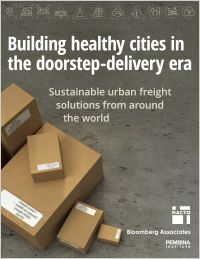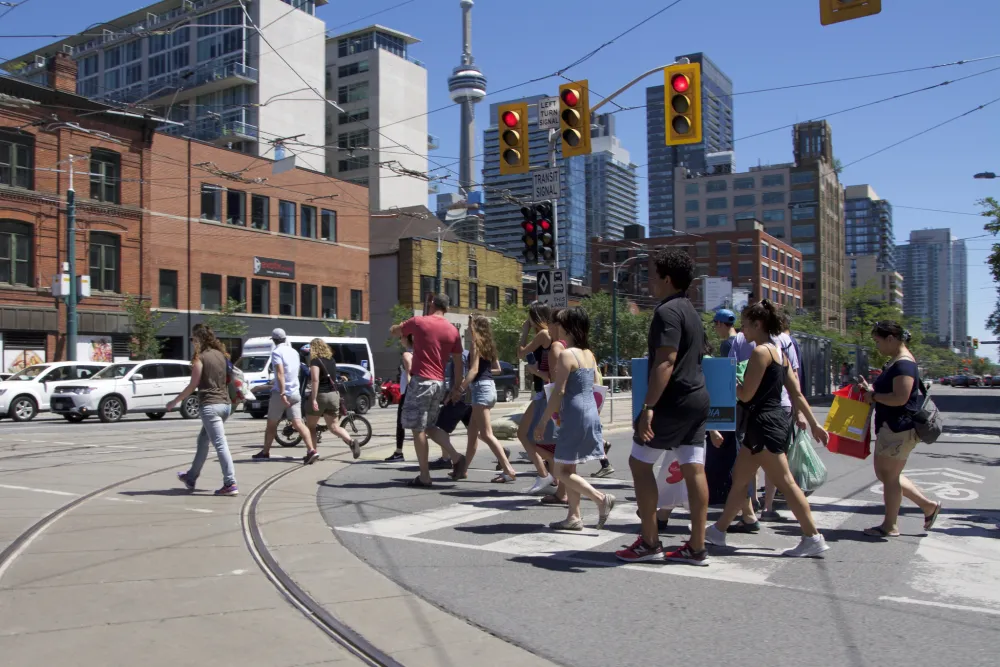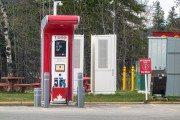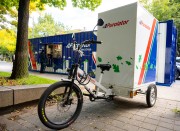An online shopping boom, accelerated by the pandemic, is increasing the number of delivery trucks in cities and, as a result, also increasing emissions, reducing road safety, and worsening congestion in urban areas. Learning how cities can manage this trend through solutions such as microhubs, zero-emission vehicles, low-emission zones and more was the main goal of an exciting webinar held on June 22.
 Cities of all sizes can access a toolkit outlining the diverse urban delivery solutions in Building healthy cities in the doorstep-delivery era: Sustainable urban freight solutions from around the world.
Cities of all sizes can access a toolkit outlining the diverse urban delivery solutions in Building healthy cities in the doorstep-delivery era: Sustainable urban freight solutions from around the world.
Collaborating with partners Bloomberg Associates and the National Association of City Transportation Officials (NACTO), Pembina Institute convened and moderated a discussion on ready-to-go solutions with several actors from the urban delivery world. Speakers included Janette Sadik-Khan of Bloomberg Associates; Meera Joshi, deputy administrator, U.S. Federal Motor Carrier Safety Administration; Francie Stefan, chief mobility officer and assistant director of transportation, City of Santa Monica; Nick Bowes, chief executive, Centre for London; Gordon Bronson, head of Urban Innovation at REEF Technology; and Andisheh Ranjbari, manager of the Urban Freight Lab at the University of Washington.
A recording of the webinar is available here. The event helped launch a new report, Building healthy cities in the doorstep-delivery era: Sustainable urban freight solutions from around the world, co-published this month by the three organizations. While the discussion provided insights for cities looking to better manage urban freight, a broad theme emerged: The solutions to the urban delivery problem will have positive impacts far beyond the freight sector. Transportation officials and city planners heard several key takeaways:
Accelerating delivery demand is a challenge for which cities were unprepared, but can act on
Bloomberg’s Janette Sadik-Khan, who authored Streetfight: Handbook for an Urban Revolution, noted that “some estimate 2022 will be the first year to record a trillion dollars in online sales,” which will be accompanied by increases in dangerous traffic congestion, pollution, and pedestrian injuries.
She highlighted, however, that there exist “vast, untapped” resources that cities can leverage to navigate this issue.
Santa Monica’s Francie Stefan echoed the idea that cities can and should do more: “I wholeheartedly agree that one of the biggest challenges is the lack of [freight] being on the radar,” she said. “Certainly, in smaller cities...often times they have the basic operational infrastructure and not the real capacity or flex to be able to take on some of the issues of freight and many of the electives don’t have it on their radar in terms of street use.” Santa Monica launched a Zero-Emission Delivery Zone pilot earlier this year.
In an article for Bloomberg CityLab on the same topic this week, Sadik-Khan detailed the specific and varied ways cities can tackle the impact of freight, such as better management of the curb. “Initiatives like SharedStreets can help,” she wrote. “It’s a digital resource that creates detailed data maps of the vast curbside network, allowing cities to analyze, manage, price and allocate space depending on needs at specific times, days and on changing needs.”
Successful management of urban delivery should include support from all levels of government, think tanks
Joining the webinar from the U.S. Department of Transportation, Deputy Administrator Meera Joshi underscored the Biden-Harris Administration’s commitment to balancing deliveries while ensuring that work occurs “in a way that’s supportive of urban vibrancy.”
Noting that 70% of freight movement in the United States happens via trucking, Joshi reinforced the importance of stakeholders and “convening think tanks” in igniting important discussions around urban delivery solutions.
There is no one-size-fits-all for urban delivery pilots
To act quick on urban delivery management, cities of all sizes should remember that “the best pilot is the one that can move forward in some way” and “teaches you something.” This observation came from Stefan, reflecting on Santa Monica’s experience in California.
It’s key to move fast on pilot deployment, Stefan noted, but also to meaningfully promote these projects to the public. One example is to create public materials explaining “why something is innovative and new” and what it’s doing for public health.
With the right approach, communities will get on board with cleaner approaches to transportation
Cities may worry that business and residents will oppose urban delivery solutions that don’t involve door-to-door delivery, such as the creation of parcel lockers that allow deliveries to be made to a central location and reduce last-mile emissions. But increased awareness of the health benefits of cleaner urban delivery is likely to help increase support for these initiatives.
Nick Bowes related this based on his experience deploying congestion pricing in the City of London, U.K. Congestion pricing entails a flat charge on polluting vehicles entering a specific area. Bowes and his team focused on the public health benefits of congestion pricing. The result? The municipal administration that implemented congestion pricing was re-elected with “68% of Londoners supporting the policy,” he said, and the city’s Ultra-Low Emission Zone, which is one of the city’s road pricing schemes, is now set to expand 20 times its original size later this year.
Public-private partnerships are key to success
Another key takeaway: partnerships are key to success for these initiatives, agreed Urban Freight Lab’s Andisheh Ranjbari and Reef Technology’s Gordon Bronson.
Bronson emphasized the new appetite in the public sector for “public-private partnerships,” in which the private sector can “bring resources, speed, and agility” to conversations on urban freight.
Adding to this, Ranjbari reiterated that many of the projects run by the Urban Freight Lab would fail if not for “partnership, collaboration, and shared understanding” between businesses like Reef, universities, and public transit agencies. Ranjbari cites Seattle’s common-carrier parcel microhub as an excellent example of such collaboration, which while good for Seattle “may not be a solution somewhere else.”







